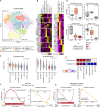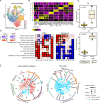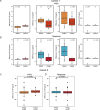Divergent tumor and immune cell reprogramming underlying immunotherapy response and immune-related adverse events in lung squamous cell carcinoma
- PMID: 37857527
- PMCID: PMC10603341
- DOI: 10.1136/jitc-2023-007305
Divergent tumor and immune cell reprogramming underlying immunotherapy response and immune-related adverse events in lung squamous cell carcinoma
Abstract
Background: Lung squamous cell carcinoma (LUSC) remains a leading cause of cancer-related deaths with few therapeutic strategies. Immune checkpoint inhibitors (ICIs) have demonstrated promising efficacy in patients with LUSC. However, ICIs could also lead to a unique spectrum of immune-related adverse events (irAEs), which dampen the clinical outcome. In-depth characterization of the immune hallmarks of antitumor responses and irAEs remains an unmet need to maximize ICI-treatment benefits of patients.
Methods: We performed single-cell RNA sequencing (scRNA-seq) on pre-ICI and on-ICI treatment tumor biopsies. We used bulk RNA-seq data of matched pretreatment/on-treatment tumors and irAE affected organs to validate observations from scRNA-seq analysis. Two independent patient cohorts were collected to determine circulating tumor necrosis factor (TNF) protein expression levels.
Results: We found that increased proportions of a macrophage subcluster with highly expressed secreted phosphoprotein 1 (SPP1) and two tumor cell subclusters in irAE patients, whereas proportions of two cytotoxic CD8+ T cell subclusters were higher in patients with partial response (PR). TNF signaling pathway was conversely associated with treatment efficacy and irAE development in most macrophage and tumor cell subclusters. Cell-cell communications for TNF ligand-receptor pairs between macrophage/T cells and tumor cells were also bidirectionally remodeled in responders versus non-responders and irAE versus non-irAE patients. Bulk RNA-seq analysis on matched pretreatment/on-treatment tumors and irAE affected organs revealed remarkably enhanced macrophage abundance and TNF signaling pathway in on-treatment tumors and organs developed irAEs. Furthermore, we observed significantly increased circulating TNF protein in plasma or serum of irAE patients but not ICI responders, based on analysis of two independent LUSC patient cohorts and one published ICI patient cohort.
Conclusions: Our data depicts specific reprogramming of macrophage, T cells and tumor cells associated with ICI response and irAEs, elucidates divergent roles of TNF signaling in antitumor immunity and irAEs, and highlights the significance of TNF expression in irAE development in the LUSC setting.
Keywords: Immune Checkpoint Inhibitors; Lung Neoplasms; Tumor Microenvironment.
© Author(s) (or their employer(s)) 2023. Re-use permitted under CC BY-NC. No commercial re-use. See rights and permissions. Published by BMJ.
Conflict of interest statement
Competing interests: None declared.
Figures






Similar articles
-
Single-cell RNA sequencing of baseline PBMCs predicts ICI efficacy and irAE severity in patients with NSCLC.J Immunother Cancer. 2025 May 22;13(5):e011636. doi: 10.1136/jitc-2025-011636. J Immunother Cancer. 2025. PMID: 40404203 Free PMC article.
-
Germline prediction of immune checkpoint inhibitor discontinuation for immune-related adverse events.J Immunother Cancer. 2025 Mar 28;13(3):e011273. doi: 10.1136/jitc-2024-011273. J Immunother Cancer. 2025. PMID: 40154961 Free PMC article.
-
Immune-Related Adverse Events by Immune Checkpoint Inhibitors Significantly Predict Durable Efficacy Even in Responders with Advanced Non-Small Cell Lung Cancer.Oncologist. 2020 Apr;25(4):e679-e683. doi: 10.1634/theoncologist.2019-0299. Epub 2019 Nov 19. Oncologist. 2020. PMID: 32297443 Free PMC article.
-
Immune-related pulmonary toxicities of checkpoint inhibitors in non-small cell lung cancer: Diagnosis, mechanism, and treatment strategies.Front Immunol. 2023 Apr 4;14:1138483. doi: 10.3389/fimmu.2023.1138483. eCollection 2023. Front Immunol. 2023. PMID: 37081866 Free PMC article. Review.
-
Association between immune-related side effects and efficacy and benefit of immune checkpoint inhibitors - A systematic review and meta-analysis.Cancer Treat Rev. 2021 Jan;92:102134. doi: 10.1016/j.ctrv.2020.102134. Epub 2020 Dec 3. Cancer Treat Rev. 2021. PMID: 33302134
Cited by
-
CD300a: An Innate Immune Checkpoint Shaping Tumor Immunity and Therapeutic Opportunity.Cancers (Basel). 2025 May 27;17(11):1786. doi: 10.3390/cancers17111786. Cancers (Basel). 2025. PMID: 40507267 Free PMC article. Review.
-
Mucin 4 expression is associated with metastasis in triple-negative breast cancer and can be tackled by soluble TNF blockade, improving immunotherapy outcome.Transl Oncol. 2025 Apr;54:102325. doi: 10.1016/j.tranon.2025.102325. Epub 2025 Feb 22. Transl Oncol. 2025. PMID: 39987883 Free PMC article.
-
PD-1/PD-L1 inhibitors plus chemotherapy versus chemotherapy alone for Chinese patients with advanced non-small-cell lung cancer: an updated meta-analysis based on phase 3 randomized controlled trials.World J Surg Oncol. 2025 Jul 10;23(1):273. doi: 10.1186/s12957-025-03934-8. World J Surg Oncol. 2025. PMID: 40640844 Free PMC article. Review.
-
Hematological parameters as predictors of immune-related adverse events: risk factor analysis in non-small cell lung cancer patients undergoing immunotherapy.Am J Transl Res. 2025 Jul 15;17(7):4976-4985. doi: 10.62347/EUHL7337. eCollection 2025. Am J Transl Res. 2025. PMID: 40821056 Free PMC article.
-
Circulating Plasma Proteins as Biomarkers for Immunotherapy Toxicity: Insights from Proteome-Wide Mendelian Randomization and Bioinformatics Analysis.Biomedicines. 2025 Jul 14;13(7):1717. doi: 10.3390/biomedicines13071717. Biomedicines. 2025. PMID: 40722787 Free PMC article.
References
Publication types
MeSH terms
LinkOut - more resources
Full Text Sources
Medical
Research Materials
Miscellaneous
